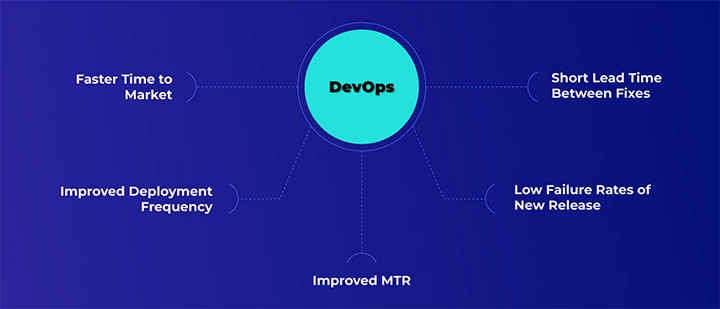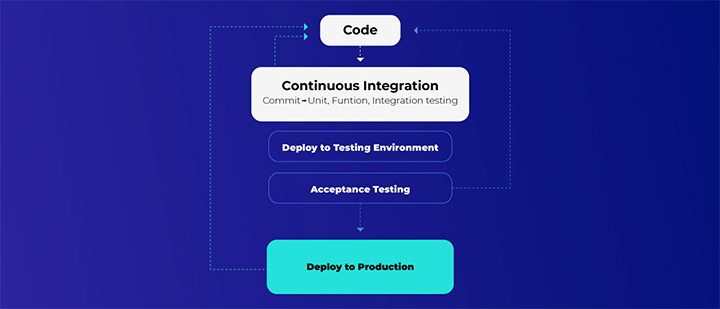

Madhushree Bharati
The Right way to Implement DevOps
DevOps, an IT way of life, brings development, operations and testing teams all together, where each team works together, taking their specific responsibility for completing the entire lifecycle of a software product.
By bringing together different teams to work in a cross-functional way, DevOps is bringing stability among the collaborative teams in the organization, resulting in reduced human errors, cost optimization, and product version improvement.

DevOps Implementation
DevOps implementation starts from exploring your current business needs and identifying objectives you want to achieve through DevOps strategy. There are two types of deployment in DevOps.
- Greenfield deployment
- Brownfield deployment
Before implementation, you must decide whether you want to go for greenfield or brownfield deployment.
Greenfield deployment
Greenfield deployment must be built from scratch. It is the installation and configuration of a new network, where no other deployment existed before. This deployment is easier but since it is done from scratch, so a bit costly.
Brownfield deployment
A brownfield deployment is an addition to an existing network. Brownfield deployment has got fewer interruptions but is tough to implement due to the need to rely on similar deployment practices.
Once you have a project in mind, the following steps are essential for DevOps’ success.
1. A Shift in work culture is a must
To simplify your cultural shift, employees should be encouraged to work in a collaborative way. The best way is to reward cross-functional teams for bringing in a better customer experience. Few organizations ask developers to work on-call to understand operations. On the other hand, other companies keep one single team leader for the development and operations team to improve transparency. It is all about teams working together, performing separate responsibilities for a single product development.
2. A continuous integration and a continuous delivery platform
Once the organization is shifted to DevOps culture, the focus is to deliver correct and updated information about the production environment to the developers so that they can deploy the product or service properly. This will help developers to focus on development as well as own the product through to production. The development team will also troubleshoot problems which falls on operations. The deployment channel should follow continuous integration, continuous development, continuous testing and continuous deployment into a single entity.
Eg: A code change triggers a new process on the build server.
- This new process does compiles the code, assembles the artifacts required for deployment to customers into deployable packages.
- Automated tests are then completed on these packages to confirm code quality is reserved and the code results are as expected.
- Once the commit stage is successful, the application is deployed for testing by a QA team.
- Finally, when the application is approved, that same release can be pushed straight to production.

3. Create a Continuous Test Environment
In the traditional testing process, the code is first developed and then it moved from development to testing area. After testing, it is moved forward to production.
In DevOps, the Quality Team and the development team works together, hence testing(whether manual or automated) becomes an integral part of development. In the continuous testing process, every change in development is tested simultaneously with development keeping the check-in and release time as short as possible.
Continuous testing process comprises of:
- Mostly prefer for automation testing (Manual testing is used mainly in usability and exploratory tests)
- For simple changes in development, easy and quick testing methods are performed during continuous development
- Log widely
- Test regularly
- Add enough QA observes
4. Create a continuous deployment system
Continuous deployment leads to continuous delivery. With continuous deployment, changes can be updated continuously resulting in quick delivery with updated features. Without manual verification, continuous deployment is a bit risky. But if you have a well-planned delivery pipeline, continuous deployment is simple. Additionally, DevOps give more granular control by automating the release of features simultaneously.
Once the developer ensures the code is perfect and the QA updates the test suites, and the delivery pipeline is well-designed, the system automatically decides its commitment to the repository and its delivery to production.
Continuous deployment is boosted with continuous control and feedback. When developers get fast feedback, proper development is done on time.
5. Use of blue and green deployment
Blue/Green deployment is used to reduce downtime and risks. When a change is made, a new deployment generated is deployed in parallel to the old(green) one. If the new deployment is successful, traffic slowly routes towards the blue deployment. And the old(green) deployment is slowly removed. If the new deployment fails, the traffic goes to the green, and the blue is removed. This is how deployment environment can be changed without any system crash.
Related Insights

